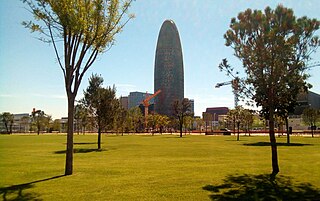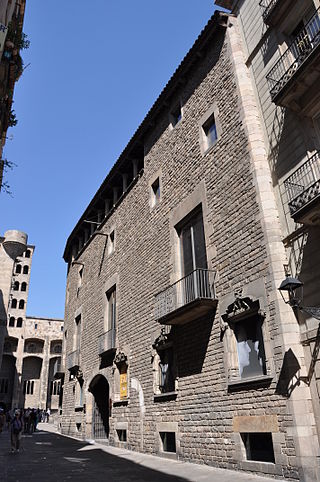
La Seu d'Urgell is a town located in Alt Urgell county in Alt Pirineu, Catalonia, Spain. The town is also the head of its judicial district and the seat of the Bishop of Urgell, one of the co-princes of Andorra. It is located the most populated town of the region, with 17.4% of its population. La Seu d'Urgell and Puigcerdà together have 30% of the population of the area.

The Eixample is a district of Barcelona between the old city and what were once surrounding small towns, constructed in the 19th and early 20th centuries. Its population was 262,000 at the last census (2005).

Ciutat Vella is a district of Barcelona, numbered District 1. The name means "old city" in Catalan and refers to the oldest neighborhoods in the city of Barcelona, Catalonia, Spain. Ciutat Vella is nestled between the Mediterranean Sea and the neighborhood called l'Eixample.

La Rambla is considered the most well known street in central Barcelona. A tree-lined pedestrian street, it stretches for 1.2 kilometres connecting the Plaça de Catalunya in its center with the Christopher Columbus Monument at Port Vell. La Rambla forms the boundary between the neighbourhoods of the Barri Gòtic to the east and the El Raval to the west.

El Raval is a neighborhood in the Ciutat Vella district of Barcelona, the capital city of Catalonia. The neighborhood, especially the part closest to the old port, was formerly (informally) known as Barri Xinès or Barrio Chino, meaning "Chinatown". El Raval is one of the two historical neighborhoods that border La Rambla, the other being the Barri Gòtic; it contains some 50,000 people.

The Mercat de Sant Josep de la Boqueria, usually simply referred to as La Boqueria, is a large public market in the Ciutat Vella district of Barcelona, Catalonia, Spain, and one of the city's foremost tourist landmarks, with an entrance from La Rambla, not far from the Liceu, Barcelona's opera house. The market has a very diverse selection of goods.

Via Laietana is a major street in Barcelona, Catalonia, Spain, in the Ciutat Vella district. The avenue runs from Plaça d'Urquinaona, at the city center, to Plaça d'Idrissa Diallo and Plaça de Correus, by the seafront, and separates the neighbourhoods of the old city it has on either side: La Ribera/El Born and Sant Pere on one and Barri Gòtic on the other. It can be seen as an extension of Carrer de Pau Claris in the Eixample.

Plaça de les Glòries Catalanes, most often shortened to Glòries, is a large square in Barcelona, first designed by Ildefons Cerdà to serve as the city centre in his original urban plan, but nowadays relegated to quite a secondary position. It is located in the Sant Martí district, bordering Eixample, at the junction of three of the city's most important thoroughfares: Avinguda Diagonal, Avinguda Meridiana and Gran Via de les Corts Catalanes.

Glòries is a station in the Barcelona Metro network, at the boundary between the Eixample and Sant Martí districts of Barcelona. It is served by TMB line L1. The station is named after the nearby Plaça de les Glòries Catalanes.

Universitat is a Barcelona Metro station named after Plaça de la Universitat, split between Eixample and Ciutat Vella districts of Barcelona, where the station is located in. This square holds the historical building of Universitat de Barcelona, celebrated for its neo-Gothic style. The station is accessible for disabled persons since 1995, when Barcelona Metro line 2 opened its platforms. It is served by TMB-operated Barcelona Metro lines L1 and L2.

Monumental is a station in the Barcelona Metro and Tram networks. It takes its name from the former La Monumental bullring located in Dreta de l'Eixample, the northern part of the central Barcelona district of Eixample. It's served by Line 2 and opened in 1995, along with the other stations on the first section of the line to be built. It's located under Carrer de la Marina between Consell de Cent and Diputació, and can be accessed from both sidewalks of Marina.

Carrer d'Aragó is a major thoroughfare in Barcelona, one of the widest and busiest roads of the districts it cuts through, especially Eixample but also Sant Martí. Its creation was passed in 1863, and was part of Ildefons Cerdà's urban plan, appearing as L Street in 1867, even though that name was never approved. Instead, another name, a reference to the Crown of Aragon, was proposed in 1863 by Víctor Balaguer, who was commissioned by the city council to rename all the streets in the area. Its Spanish-language rendition, Calle de Aragón, was the official designation back then. It starts in Carrer de Tarragona and it becomes Rambla de Guipúscoa at the intersection with Carrer de Lope de Vega.

Plaça de Mossèn Jacint Verdaguer is a square in the Eixample district of Barcelona, Catalonia, Spain. It lies in the intersection between Avinguda Diagonal, the city's main avenue, and Passeig de Sant Joan, in Dreta de l'Eixample, not far from the Sagrada Família.

Sant Antoni is a neighborhood in the Eixample district of Barcelona, Catalonia (Spain). Its non-official centre, the marketplace of the same name—designed by Antoni Rovira i Trias and built between 1872 and 1882—is one of the oldest and most popular in the city, especially with the secondhand book stalls that surround the building Sunday mornings. It is bordered by the neighbourhoods of the L'Antiga Esquerra de l'Eixample, the Raval, and Poble Sec. The streets of Sant Antoni follow the grid pattern prevalent in all of Eixample, except for a central thoroughfare, the Avinguda de Mistral, built on the site of an important medieval road which led out of Barcelona. Another well-known landmark of Sant Antoni is the bar called Els Tres Tombs, right next to the market.

The Museum of the History of Barcelona is a history museum that conserves, researches, communicates and exhibits the historical heritage of the city of Barcelona, from its origins in Roman times until the present day. The museum's headquarters are located on Plaça del Rei, in the Barcelona Gothic Quarter. It also manages several historic sites all around the city, most of them archaeological sites displaying remains of the ancient Roman city, called Barcino in Latin. Some others date to medieval times, including the Jewish quarter and the medieval royal palace called the Palau Reial Major. The rest are contemporary, among them old industrial buildings and sites related to Antoni Gaudí and the Spanish Civil War.

The following outline is provided as an overview of and topical guide to Barcelona:

The odonyms of Barcelona — meaning the street names in Barcelona along with the names of thoroughfares and other roads in the city — are regulated by the Ponència de Nomenclàtor dels Carrers de Barcelona, a commission under the Department of Culture of the Barcelona City Council.

The urban planning of Barcelona developed in accordance with the historical and territorial changes of the city, and in line with other defining factors of public space, such as architecture, urban infrastructure and the adaptation and maintenance of natural spaces, parks and gardens.

























